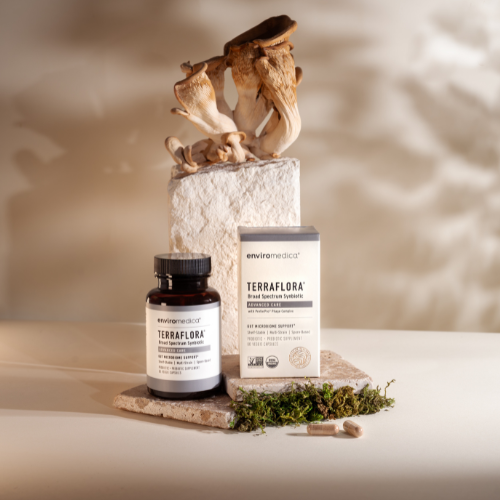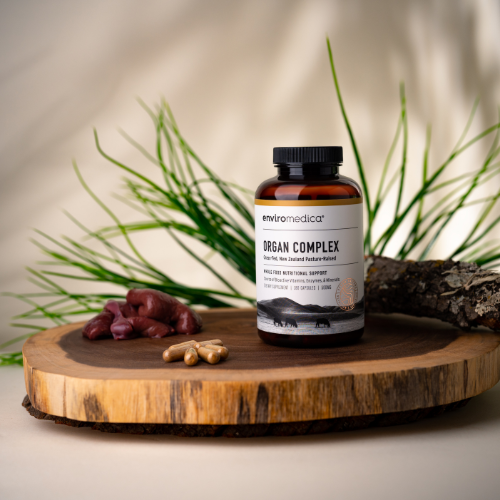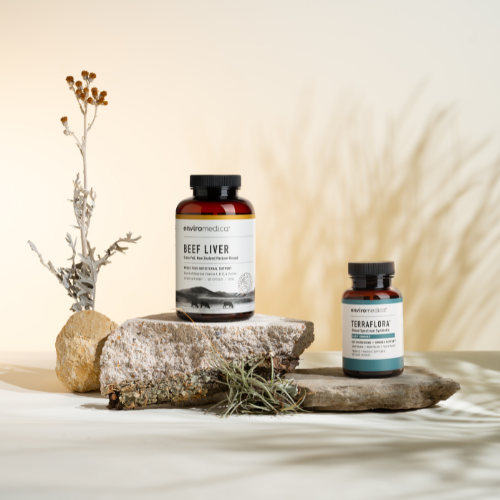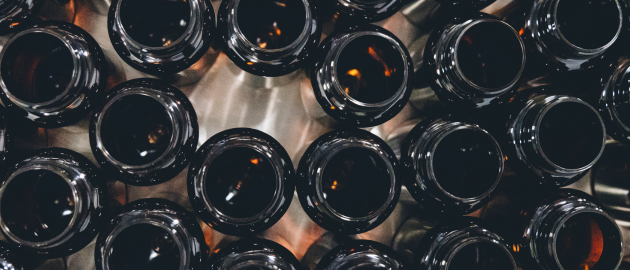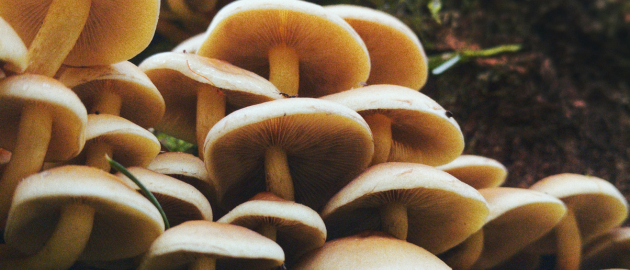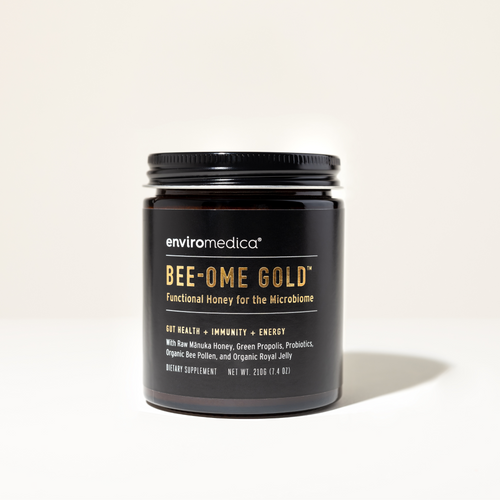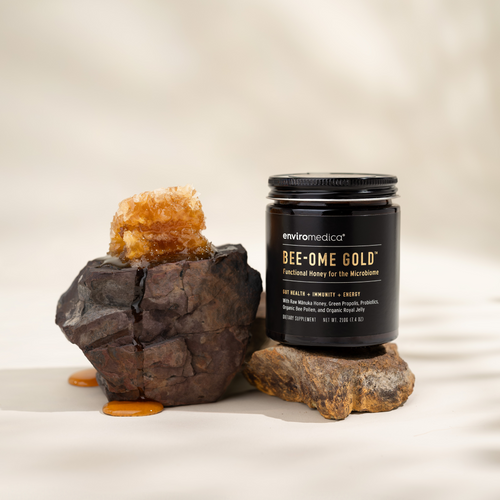Ancient nutrition meets modern microbiome science in this deep dive into honeybee hive ingredients and their incredible benefits.
The hive as a healing system
Honeybees are more than honey-makers—they're nature's master herbalists. Their hives produce an entire pharmacopeia of functional ingredients: honey, bee pollen, royal jelly, and propolis. For thousands of years, humans have relied on these substances not only as nourishment but also as healing agents.
Now, modern science is catching up, validating the role of these hive products as rich sources of antioxidants, antimicrobial agents, and compounds that support gut, immune, cardiovascular, cognitive, metabolic, and skin health.1-15
Evolutionary allies: Bees and humans
The relationship between humans and honeybees goes back millions of years. Honeybees evolved with flowering plants around 120 million years ago, and our own ancestors likely foraged their hives for energy-rich honey long before the dawn of agriculture.20,40,44
Traditional societies like the Hadza still include honey as a major dietary staple, consuming it from diverse wild bee species year-round. Ancient Egyptian, Greek, Roman, Chinese, and Ayurvedic texts also speak to honey's use for wound healing and digestion.41-42
This long-standing reliance frames bee products as a core part of ancestral nutrition.
The hive ingredients: Nature's synbiotic
Let’s break down the core functional hive components and what they bring to human health:
- Honey: More than a sweetener, honey is a powerhouse of polyphenols and oligosaccharides that make it both antimicrobial and prebiotic—a duplibiotic or even a synbiotic when paired with gut-friendly bacteria like Bacillus.7,22,53,81
- Bee Pollen: Sometimes called “life-giving dust,” it’s packed with protein, amino acids, fiber, vitamins, and over 200 bioactive compounds.8-10,59 Germany even classifies it as medicinal.
- Royal Jelly: This nutrient-dense secretion sustains queen bees for years and contains 10-HDA, a fatty acid with antifungal and biofilm-disrupting potential. It may also influence healthy aging and support gut and mycobiome balance.12,22,89
- Propolis: A resinous “bee glue” with potent antimicrobial properties, propolis supports both hive immunity and gut microbiome modulation. Its phenolic compounds, like Artepillin C, have shown antifungal, antioxidant, and anti-cancer activity.6,16,93
Together, these ingredients offer a holistic approach to health that supports the gut and beyond.
Gut health: The core of whole-body wellness
The gut is the command center for many body systems, and honeybee products uniquely influence microbial balance in a dual-action way:
- Inhibit pathogens via antibacterial and antifungal compounds like MGO (in Mānuka honey) and 10-HDA.
- Support beneficial bacteria through prebiotics and synbiotic Bacillus spores naturally present in bee-collected pollen.25-26,21,
This balance has downstream effects on:
- Immune function66-69
- Digestion and inflammation70
- Mental health and neuroprotection3-4,74-77
- Metabolic regulation and insulin sensitivity78-81
- Skin clarity and resilience12-13,82
Functional honey in action: The science behind the claims
- GERD Study: Participants with gastroesophageal reflux who took Mānuka honey (5g, 3x/day) showed significant symptom improvement vs. placebo after just 2 weeks.70
- Cancer Cell Research: Mānuka honey and Brazilian green propolis extracts demonstrate dose-dependent cytotoxicity against various cancer cell lines.6,68-69
- Metabolic Health: Clinical studies show honey can reduce triglycerides, blood glucose, LDL, and C-reactive protein while improving HDL and even body composition.72
- Cognition & Brain Health: Honey's polyphenols and royal jelly's amino acids help modulate BDNF pathways, oxidative stress, and inflammation—key to supporting memory and neuroplasticity.3,75-77
The ecosystem effect
Where bees forage determines the health benefits of what they produce.
Undisturbed ecosystems support stronger bee colonies and richer, more medicinal hive products. While agrochemical exposure, like glyphosate, can contaminate honey and harm bee cognition, gut microbes, and development.47-52 Another important element is floral diversity, which influences the unique bioactives found in honeys like Mānuka (MGO) or Brazilian green propolis (Artepillin C).6-7,11
To get the full benefits of functional honey, the source matters.
Bee-Ome Gold: Functional honey for the microbiome
Enviromedica’s Bee-Ome Gold™ is a modern expression of ancestral nutrition. It delivers a full-spectrum hive blend sourced from pristine ecosystems:
New Zealand Raw Mānuka Honey (MGO-rich)
Organic Wild Spanish Bee Pollen
Organic Royal Jelly (10-HDA)
Brazilian Green Propolis Extract (Artepillin C)
Spore-based Probiotics (Bacillus species)
Together, these ingredients form a potent synbiotic designed to support gut health, immunity, and whole-body vitality.
The whole hive is the medicine
Science affirms what traditional cultures always knew: bee products aren't just superfoods, they're symbiotic with human biology. Ingesting them brings us into relationship with nature's cycles and strengthens our internal ecosystems.
Bee-Ome Gold™ is a daily ritual rooted in ecosystem health and evolutionary wisdom.
Let the hive support your health—from the inside out.
References
- 1. Giampieri, F., et al., Bee Products: An Emblematic Example of Underutilized Sources of Bioactive Compounds. Journal of Agricultural and Food Chemistry, 2022. 70(23): p. 6833-6848.
- 2. Zamri, N.A., et al., Honey on brain health: A promising brain booster. Frontiers in Aging Neuroscience, 2023. 14.
- 3. Zulkifli, N.A., et al., The potential neuroprotective effects of stingless bee honey. Frontiers in Aging Neuroscience, 2023. 14.
- 4. Azman, K.F. and R. Zakaria, Honey as an antioxidant therapy to reduce cognitive ageing. Iran J Basic Med Sci, 2019. 22(12): p. 1368-1377.
- 5. Azman, K.F., et al., Tualang Honey: A Decade of Neurological Research. Molecules, 2021. 26(17): p. 5424.
- 6. Beserra, F.P., et al., Artepillin C as an outstanding phenolic compound of Brazilian green propolis for disease treatment: A review on pharmacological aspects. Phytother Res, 2021. 35(5): p. 2274-2286.
- 7. Carter, D.A., et al., Therapeutic Manuka Honey: No Longer So Alternative. Front Microbiol, 2016. 7: p. 569.
- 8. El Ghouizi, A., et al., Bee Pollen as Functional Food: Insights into Its Composition and Therapeutic Properties. Antioxidants, 2023. 12(3): p. 557.
- 9. Kacemi, R. and M.G. Campos, Translational Research on Bee Pollen as a Source of Nutrients: A Scoping Review from Bench to Real World. Nutrients, 2023. 15(10): p. 2413.
- 10. Khalifa, S.A.M., et al., Bee Pollen: Current Status and Therapeutic Potential. Nutrients, 2021. 13(6): p. 1876.
- 11. Kot, B., et al., Effect of manuka honey on biofilm-associated genes expression during methicillin-resistant Staphylococcus aureus biofilm formation. Scientific Reports, 2020. 10(1).
- 12. Kunugi, H. and A. Mohammed Ali, Royal Jelly and Its Components Promote Healthy Aging and Longevity: From Animal Models to Humans. Int J Mol Sci, 2019. 20(19).
- 13. Pasupuleti, V.R., et al., Honey, Propolis, and Royal Jelly: A Comprehensive Review of Their Biological Actions and Health Benefits. Oxidative Medicine and Cellular Longevity, 2017. 2017: p. 21.
- 14. Algethami, J.S., et al., Bee Pollen: Clinical Trials and Patent Applications. Nutrients, 2022. 14(14): p. 2858.
- 15. Anjum, S.I., et al., Composition and functional properties of propolis (bee glue): A review. Saudi J Biol Sci, 2019. 26(7): p. 1695-1703.
- 16. Smutin, D., et al., Micro”bee”ota: Honey Bee Normal Microbiota as a Part of Superorganism. Microorganisms, 2022. 10(12): p. 2359.
- 17. Remolina, S.C. and K.A. Hughes, Evolution and mechanisms of long life and high fertility in queen honey bees. AGE, 2008. 30(2-3): p. 177-185.
- 18. Ratnieks, F.L.W. and H. Helanterä, The evolution of extreme altruism and inequality in insect societies. Philosophical Transactions of the Royal Society B: Biological Sciences, 2009. 364(1533): p. 3169-3179.
- 19. Zhang, L., et al., The Effect of Comb Cell Size on the Development of Apis mellifera Drones. Life, 2024. 14(2): p. 222.
- 20. Murray, E.A., S. Bossert, and B.N. Danforth, Pollinivory and the diversification dynamics of bees. Biology Letters, 2018. 14(11): p. 20180530.
- 21. Pratt, S.C., Collective control of the timing and type of comb construction by honey bees (Apis mellifera). Apidologie, 2004. 35(2): p. 193-205.
- 22. Bagameri, L., G.-M. Baci, and D.S. Dezmirean, Royal Jelly as a Nutraceutical Natural Product with a Focus on Its Antibacterial Activity. Pharmaceutics, 2022. 14(6): p. 1142.
- 23. Harwood, G., et al., Social immunity in honey bees: royal jelly as a vehicle in transferring bacterial pathogen fragments between nestmates. Journal of Experimental Biology, 2021. 224(7).
- 24. Nagari, M., Y. Brenner, and G. Bloch, Nurse honeybee workers tend capped-brood, which does not require feeding, around-the-clock. Journal of Experimental Biology, 2017. 220(22): p. 4130-4140.
- 25. Alippi, A., L. Fernández, and A. López, Diversity of aerobic spore-forming bacteria isolated from fresh bee pollen intended for human consumption in Argentina. Journal of Apicultural Research, 2022. 61(3): p. 392-399.
- 26. Beekman, M. and F.L.W. Ratnieks, Long‐range foraging by the honey‐bee, <i>Apis mellifera</i> L. Functional Ecology, 2000. 14(4): p. 490-496.
- 27. Cano, R.J. and M.K. Borucki, Revival and Identification of Bacterial Spores in 25- to 40-Million-Year-Old Dominican Amber. Science, 1995. 268(5213): p. 1060-1064.
- 28. Nicolson, S.W., H. Human, and C.W.W. Pirk, Honey bees save energy in honey processing by dehydrating nectar before returning to the nest. Scientific Reports, 2022. 12(1).
- 29. Kovac, H., A. Stabentheiner, and R. Brodschneider, Contribution of honeybee drones of different age to colonial thermoregulation. Apidologie, 2009. 40(1): p. 82-95.
- 30. Alaerjani, W.M.A., et al., Biochemical Reactions and Their Biological Contributions in Honey. Molecules, 2022. 27(15): p. 4719.
- 31. Topitzhofer, E., et al., Collection and Identification of Pollen from Honey Bee Colonies. Journal of Visualized Experiments, 2021(167).
- 32. Komosinska-Vassev, K., et al., Bee pollen: chemical composition and therapeutic application. Evid Based Complement Alternat Med, 2015. 2015: p. 297425.
- 33. Saelao, P., et al., Honeybee microbiome is stabilized in the presence of propolis. Biology Letters, 2020. 16(5): p. 20200003.
- 34. Garcia-Mazcorro, J.F., J.R. Kawas, and A.G. Marroquin-Cardona, Descriptive Bacterial and Fungal Characterization of Propolis Using Ultra-High-Throughput Marker Gene Sequencing. Insects, 2019. 10(11): p. 402.
- 35. Lindberg, H. What do you really know about bees? 2017 6 Dec 2017 [cited 2024 18 May 2024]; Available from: https://www.canr.msu.edu/news/what_do_you_really_know_about_bees.
- 36. Dogantzis, K., et al., Thrice out of Asia and the adaptive radiation of the western honey bee. Science Advances, 2021. 7.
- 37. Han, F., A. Wallberg, and M.T. Webster, From where did the <scp>W</scp>estern honeybee (<i><scp>A</scp>pis mellifera)</i> originate? Ecology and Evolution, 2012. 2(8): p. 1949-1957.
- 38. Brunet, M., et al., A new hominid from the Upper Miocene of Chad, Central Africa. Nature, 2002. 418(6894): p. 145-151.
- 39. Harcourt‐Smith, W.E.H. and L.C. Aiello, Fossils, feet and the evolution of human bipedal locomotion. Journal of Anatomy, 2004. 204(5): p. 403-416.
- 40. Marlowe, F.W., et al., Honey, Hadza, hunter-gatherers, and human evolution. J Hum Evol, 2014. 71: p. 119-28.
- 41. Onyango, L.A. and J. Liang, Manuka honey as a non-antibiotic alternative against Staphylococcus spp. and their small colony variant (SCVs) phenotypes. Frontiers in Cellular and Infection Microbiology, 2024. 14.
- 42. Blair, S.E. and D.A. Carter, The potential for honey in the management of wounds and infection. Australian Infection Control, 2005. 10(1): p. 24-31.
- 43. Roffet-Salque, M., et al., Widespread exploitation of the honeybee by early Neolithic farmers. Nature, 2015. 527(7577): p. 226-230.
- 44. Crittenden, A.N., The Importance of Honey Consumption in Human Evolution. Food and Foodways, 2011. 19(4): p. 257-273.
- 45. Naug, D., Nutritional stress due to habitat loss may explain recent honeybee colony collapses. Biological Conservation, 2009. 142(10): p. 2369-2372.
- 46. Geldert, C., et al., Dietary supplementation with phytochemicals improves diversity and abundance of honey bee gut microbiota. Journal of Applied Microbiology, 2021. 130(5): p. 1705-1720.
- 47. Harwood, G.P. and A.G. Dolezal, Pesticide–Virus Interactions in Honey Bees: Challenges and Opportunities for Understanding Drivers of Bee Declines. Viruses, 2020. 12(5): p. 566.
- 48. Insolia, L., et al., Honey bee colony loss linked to parasites, pesticides and extreme weather across the United States. Scientific Reports, 2022. 12(1): p. 20787.
- 49. Farina, W.M., et al., Effects of the Herbicide Glyphosate on Honey Bee Sensory and Cognitive Abilities: Individual Impairments with Implications for the Hive. Insects, 2019. 10(10): p. 354.
- 50. Berg, C.J., et al., Glyphosate residue concentrations in honey attributed through geospatial analysis to proximity of large-scale agriculture and transfer off-site by bees. PLOS ONE, 2018. 13(7): p. e0198876.
- 51. Costas-Ferreira, C., R. Durán, and L.R.F. Faro, Toxic Effects of Glyphosate on the Nervous System: A Systematic Review. Int J Mol Sci, 2022. 23(9).
- 52. Marino, M., et al., Pleiotropic Outcomes of Glyphosate Exposure: From Organ Damage to Effects on Inflammation, Cancer, Reproduction and Development. Int J Mol Sci, 2021. 22(22).
- 53. Schell, K.R., et al., The Potential of Honey as a Prebiotic Food to Re-engineer the Gut Microbiome Toward a Healthy State. Frontiers in Nutrition, 2022. 9.
- 54. Li, X.V., I. Leonardi, and I.D. Iliev, Gut Mycobiota in Immunity and Inflammatory Disease. Immunity, 2019. 50(6): p. 1365-1379.
- 55. Fernandes, L., et al., Honey as a Strategy to Fight Candida tropicalis in Mixed-Biofilms with Pseudomonas aeruginosa. Antibiotics, 2020. 9(2): p. 43.
- 56. Mohan, A., et al., Effect of honey in improving the gut microbial balance. Food Quality and Safety, 2017. 1(2): p. 107-115.
- 57. Wallace, A., et al., Demonstrating the safety of manuka honey UMF® 20+in a human clinical trial with healthy individuals. British Journal of Nutrition, 2010. 103(7): p. 1023-1028.
- 58. Fan, Y. and O. Pedersen, Gut microbiota in human metabolic health and disease. Nat Rev Microbiol, 2021. 19(1): p. 55-71.
- 59. Rodríguez-Pólit, C., et al., Chemical Properties and Biological Activity of Bee Pollen. Molecules, 2023. 28(23): p. 7768.
- 60. Ke, S., et al., Gut feelings: associations of emotions and emotion regulation with the gut microbiome in women. Psychological Medicine, 2023. 53(15): p. 7151-7160.
- 61. Dicks, L.M.T., Gut Bacteria and Neurotransmitters. Microorganisms, 2022. 10(9): p. 1838.
- 62. Vidal-Veuthey, B., D. González, and J.P. Cárdenas, Role of microbial secreted proteins in gut microbiota-host interactions. Frontiers in Cellular and Infection Microbiology, 2022. 12.
- 63. Liu, J., et al., Functions of Gut Microbiota Metabolites, Current Status and Future Perspectives. Aging and disease, 2022. 13(4): p. 1106.
- 64. Cao, Z., et al., The gut virome: A new microbiome component in health and disease. eBioMedicine, 2022. 81: p. 104113.
- 65. Sam, Q., M. Chang, and L. Chai, The Fungal Mycobiome and Its Interaction with Gut Bacteria in the Host. International Journal of Molecular Sciences, 2017. 18(2): p. 330.
- 66. Ayoub, W.S., et al., Exploiting the polyphenolic potential of honey in the prevention of chronic diseases. Food Chemistry Advances, 2023. 3: p. 100373.
- 67. Pasupuleti, V.R., et al., Biological and therapeutic effects of honey produced by honey bees and stingless bees: a comparative review. Revista Brasileira de Farmacognosia, 2016. 26(5): p. 657-664.
- 68. Bazaid, A.S., et al., Antioxidant, Anticancer, Antibacterial, Antibiofilm Properties and Gas Chromatography and Mass Spectrometry Analysis of Manuka Honey: A Nature’s Bioactive Honey. Applied Sciences, 2022. 12(19): p. 9928.
- 69. Wu, Y.-D. and Y.-J. Lou, A steroid fraction of chloroform extract from bee pollen of Brassica campestris induces apoptosis in human prostate cancer PC-3 cells. Phytotherapy Research, 2007. 21(11): p. 1087-1091.
- 70. Gośliński, M., et al., Application of Manuka honey in treatment patients with GERD. Food Sci Nutr, 2024. 12(1): p. 172-179.
- 71. Olas, B., Honey and Its Phenolic Compounds as an Effective Natural Medicine for Cardiovascular Diseases in Humans? Nutrients, 2020. 12(2): p. 283.
- 72. Yaghoobi, N., et al., Natural Honey and Cardiovascular Risk Factors; Effects on Blood Glucose, Cholesterol, Triacylglycerole, CRP, and Body Weight Compared with Sucrose. The Scientific World JOURNAL, 2008. 8: p. 463-469.
- 73. Palma-Morales, M., J.R. Huertas, and C. Rodríguez-Pérez, A Comprehensive Review of the Effect of Honey on Human Health. Nutrients, 2023. 15(13): p. 3056.
- 74. Che Mohd Nassir, C.M.N., et al., Neuroprotective Potentials of Honey for Cerebral Small Vessel Disease. OBM Neurobiology, 2022. 06(04): p. 144.
- 75. El Gaamouch, F., et al., Benefits of dietary polyphenols in Alzheimer’s disease. Frontiers in Aging Neuroscience, 2022. 14.
- 76. Iftikhar, A., et al., Potential Therapeutic Benefits of Honey in Neurological Disorders: The Role of Polyphenols. Molecules, 2022. 27(10): p. 3297.
- 77. Szwajgier, D., et al., Honeys as Possible Sources of Cholinesterase Inhibitors. Nutrients, 2022. 14(14): p. 2969.
- 78. Ramli, N., et al., A Review on the Protective Effects of Honey against Metabolic Syndrome. Nutrients, 2018. 10(8): p. 1009.
- 79. Bobiş, O., D.S. Dezmirean, and A.R. Moise, Honey and Diabetes: The Importance of Natural Simple Sugars in Diet for Preventing and Treating Different Type of Diabetes. Oxidative Medicine and Cellular Longevity, 2018. 2018: p. 1-12.
- 80. Morita, H., et al., Effect of royal jelly ingestion for six months on healthy volunteers. Nutrition Journal, 2012. 11(1): p. 77.
- 81. Rodríguez-Daza, M.C., et al., Polyphenol-Mediated Gut Microbiota Modulation: Toward Prebiotics and Further. Frontiers in Nutrition, 2021. 8.
- 82. McLoone, P., et al., Honey: A Therapeutic Agent for Disorders of the Skin. Central Asian Journal of Global Health, 2016. 5(1).
- 83. Yoo, S., et al., The Role of Prebiotics in Modulating Gut Microbiota: Implications for Human Health. International Journal of Molecular Sciences, 2024. 25(9): p. 4834.
- 84. Cheng, N., et al., Impact of SchisandraChinensis Bee Pollen on Nonalcoholic Fatty Liver Disease and Gut Microbiota in HighFat Diet Induced Obese Mice. Nutrients, 2019. 11(2): p. 346.
- 85. Lu, J., et al., Manuka-type honeys can eradicate biofilms produced by Staphylococcus aureus strains with different biofilm-forming abilities. PeerJ, 2014: p. 25.
- 86. Girma, A., W. Seo, and R.C. She, Antibacterial activity of varying UMF-graded Manuka honeys. PLOS ONE, 2019. 14(10): p. e0224495.
- 87. Hammond, E.N. and E.S. Donkor, Antibacterial effect of Manuka honey on Clostridium difficile. BMC Research Notes, 2013. 6(1): p. 188.
- 88. Gośliński, M., D. Nowak, and L. Kłębukowska, Antioxidant properties and antimicrobial activity of manuka honey versus Polish honeys. J Food Sci Technol, 2020. 57(4): p. 1269-1277.
- 89. Altuntaş, S., A. Yigit Cinar, and V. Altuntaş, Modelling of Listeria monocytogenes growth and survival in presence of royal jelly: a promising anti-biofilm agent. Journal of food and nutrition research, 2020.
- 90. El-Gayar, M.H., et al., Evaluation of lyophilized royal jelly and garlic extract emulgels using a murine model infected with methicillin-resistant Staphylococcus aureus. AMB Express, 2022. 12(1).
- 91. Ilie, C.-I., et al., Bee Pollen Extracts: Chemical Composition, Antioxidant Properties, and Effect on the Growth of Selected Probiotic and Pathogenic Bacteria. Antioxidants, 2022. 11(5): p. 959.
- 92. Sokolonski, A.R., et al., Activity of antifungal drugs and Brazilian red and green propolis extracted with different methodologies against oral isolates of Candida spp. BMC Complementary Medicine and Therapies, 2021. 21(1).
- 93. Machado, B.A.S., et al., Chemical Composition and Biological Activity of Extracts Obtained by Supercritical Extraction and Ethanolic Extraction of Brown, Green and Red Propolis Derived from Different Geographic Regions in Brazil. PLOS ONE, 2016. 11(1): p. e0145954.
- 94. Bezerra, C.R.F., et al., Highly efficient antibiofilm and antifungal activity of green propolis against Candida species in dentistry materials. PLOS ONE, 2020. 15(12): p. e0228828.
- 95. Vestby, L.K., et al., Bacterial Biofilm and its Role in the Pathogenesis of Disease. Antibiotics, 2020. 9(2): p. 59.
- 96. Cairns, V., Supporting patients with long-term problems after Lyme disease. BJGP Open, 2020. 4(3): p. bjgpopen20X1011.
- 97. Veiga, R.S., et al., Artepillin C and phenolic compounds responsible for antimicrobial and antioxidant activity of green propolis and Baccharis dracunculifolia DC. Journal of Applied Microbiology, 2017. 122(4): p. 911-920.
-
98. Daudu, O.M., Bee Pollen Extracts as Potential Antioxidants and Inhibitors of α-Amylase and α-Glucosidase Enzymes <i>In Vitro</i> Assessment. Journal of Apicultural Science, 2019. 63(2): p. 315-325.
